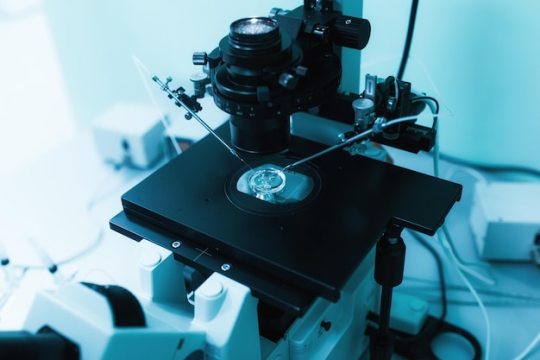#Microscope Market size
Explore tagged Tumblr posts
Text
Microscope Market Analysis, Opportunities And Forecast Report 2024-2030
The global microscope market size was estimated at USD 11.94 billion in 2023 and is projected to grow at a compound annual growth rate (CAGR) of 8.0% from 2024 to 2030.
Growing applications and high demand for technologically advanced magnification devices is driving the market. Furthermore, the market is experiencing growth due to increased demand from the healthcare sector and the rapidly expanding semiconductor industry. Additionally, the adoption of microscopy to facilitate research endeavors fuels the demand for microscopes.
Gather more insights about the market drivers, restrains and growth of the Microscope Market
In order to improve market penetration, the microscope industry is currently undergoing advancements in technology, developing types that boast faster performance and incorporate user-friendly sample preparation techniques. Furthermore, the ongoing technical advancements, including integration with display modalities for high-definition imaging and 3-dimensional views, are poised to drive increased demand for microscopes throughout the forecast period.
The sector is expanding through the incorporation of cutting-edge technologies such as the Internet of Things (IoT) and extended ultraviolet lithography (EUVL) and deep learning. IoT creates a need for memory, connectivity, sensors, and microcontrollers, employing neural networks to improve the type of Integrated Circuits (ICs). Meanwhile, EUVL plays a pivotal role in the manufacturing of high-end computing chips. Electron microscopy, providing high-resolution imaging, enables a thorough assessment ranging from packaged devices to atomic-level gate structures. Systems based on electron beams are applied in scrutinizing the sources of device failures to optimize the manufacturing process.
The growing emphasis on research and development in areas like neuroscience, life sciences, nanotechnology, and semiconductor technology is anticipated to drive the adoption of microscopes. These instruments, known for their high image resolution, are essential for investigating cell signaling pathways and studying cancer cell proliferation. Furthermore, scanning probe microscopes offer versatility by not relying on the wavelength of the light source for magnification, making them suitable for diverse environments such as gas and liquid and allowing the examination of insulator and conductor specimens.
Browse through Grand View Research's Medical Devices Industry Research Reports.
• The global pulsed field ablation market size was estimated at USD 116.6 million in 2023 and is projected to grow at a CAGR of 37.7% from 2024 to 2030.
• The global retinal imaging devices market size was estimated at USD 3.74 billion in 2023 and is expected to grow at a CAGR 7.9% from 2024 to 2030.
Microscope Market Segmentation
Grand View Research has segmented the global microscope market report based on type, application, and region:
Type Outlook (Revenue, USD Million, 2018 - 2030)
• Optical
• Electron
• Scanning Probe
• Others
Application Outlook (Revenue, USD Million, 2018 - 2030)
• Material Science
• Nanotechnology
• Life Science
• Semiconductors
• Other Applications
Regional Outlook (Revenue, USD Million, 2018 - 2030)
• North America
• U.S.
• Canada
• Europe
• UK
• Germany
• France
• Italy
• Spain
• Denmark
• Sweden
• Norway
• Asia Pacific
• Japan
• China
• India
• South Korea
• Australia
• Thailand
• Latin America
• Brazil
• Mexico
• Argentina
• Middle East & Africa
• South Africa
• Saudi Arabia
• UAE
• Kuwait
Key Microscope Company Insights
Key players such as Thermo Fisher Scientific, Inc, Bruker Corporation and Zeiss Group have been focusing on product innovation, expanding their service offerings, and improving operational efficiency. Additionally, these industry leaders often engage in strategic collaborations, acquisitions, and partnerships to strengthen their market presence and maintain a competitive edge in the rapidly evolving field of microscopy.
Emerging players such as CAMECA and Joel ltd. are actively pursuing strategies to establish their presence by introducing innovative technologies, forming strategic partnerships, and focusing on niche applications. Furthermore, these players are leveraging technological advancements and strategic partnerships to compete effectively with established market leaders.
Key Microscope Companies:
The following are the leading companies in the microscope market. These companies collectively hold the largest market share and dictate industry trends. Financials, strategy maps & products of these microscope companies are analyzed to map the supply network.
• Zeiss Group
• Bruker Corporation
• CAMECA
• Thermo Fisher Scientific, Inc.
• Nikon Corporation
• Olympus Corporation
• NT-MDT SI
• Hitachi High-Tech Corporation
• JEOL Ltd.
• Oxford Instruments (Asylum Corporation)
Recent Developments
• In November 2023, Ashoka University partnered with Carl Zeiss India (Bangalore) Pvt. Ltd. to establish a core imaging facility. Under this partnership Carl Zeiss India will provide Ashoka University with microscopy technology.
• In July 2023, at the Microscopy and Microanalysis (M&M) 2023 Conference, ZEISS Microscopy presents an array of interactive display features, highlighting new Type launches and introducing emerging researchers.
• In April 2023, Nikon unveiled the ECLIPSE Ui, Japan's inaugural digital imaging microscope designed for medical applications, with the goal of enhancing the efficiency of pathological observation and facilitating data sharing.
Order a free sample PDF of the Microscope Market Intelligence Study, published by Grand View Research.
#Microscope Market#Microscope Industry#microscope industry growth rate#Microscope Market size#Microscope Market share
0 notes
Text
Scanning Electron Microscopes Market Growth Factors, Trends, and Emerging Opportunities
The global scanning electron microscopes (SEM) market is experiencing significant growth, driven by advancements in nanotechnology, materials science research, and increased applications across various industries. Valued at USD 4.75 billion in 2023, the market is projected to reach USD 9.36 billion by 2032, exhibiting a compound annual growth rate (CAGR) of 9.77% during the forecast period.
Market Segmentation:
The SEM market is segmented based on type and application:
By Type:
Benchtop SEM
Conventional SEM
Field Emission SEM (FE-SEM): Leading the market with a 38% share in 2023, FE-SEM offers high-resolution imaging essential for detailed analysis in research and industrial applications.
Variable Pressure SEM
By Application:
Material Science
Nanotechnology
Life Science
Semiconductors
Others
Get Free Sample Report @ https://www.snsinsider.com/sample-request/1199
Regional Analysis:
The Asia-Pacific region, particularly countries like India and China, is witnessing rapid growth in SEM demand due to the burgeoning semiconductor industry and increased outsourcing of electronic equipment manufacturing. North America and Europe continue to hold significant market shares, driven by substantial investments in research and development across various scientific domains.
KEY PLAYERS:
The key market players are Bruker Corp., Danish Micro Engineering (DME), Thermo Fisher Scientific, Hitachi High Technologies Corp., JEOL Ltd., Leica Microsystems, Nanoscience Instruments, Inc., Nikon Corp., Olympus Corp., Carl Zeiss & other players.
Key Highlights:
Rising applications of SEM in nanotechnology and materials science research are propelling market growth.
Continuous innovations in SEM technology, such as improved resolution and faster imaging, are driving demand across various industries.
High costs associated with SEMs and the need for specialized training may pose challenges to market expansion.
Future Outlook:
The SEM market is poised for robust growth, fueled by ongoing technological advancements and expanding applications in emerging fields. Opportunities abound in developing SEMs with AI-driven analysis and automated workflows, enhancing usability and attracting new users. Additionally, growing industrialization and research initiatives in emerging economies present significant prospects for market expansion.
Conclusion:
The global scanning electron microscopes market is on a promising trajectory, with substantial growth anticipated across various segments and regions. Stakeholders, including manufacturers, researchers, and investors, stand to benefit from the evolving landscape of SEM technology.
Contact Us: Jagney Dave - Vice President of Client Engagement Phone: +1-315 636 4242 (US) | +44- 20 3290 5010 (UK)
Other Related Reports:
Medical Display Market Size
Medical Waste Containers Market Size
IoT Medical Devices Market Size
eClinical Solutions Market
#Scanning Electron Microscopes Market#Scanning Electron Microscopes Market Share#Scanning Electron Microscopes Market Trends#Scanning Electron Microscopes Market Growth#Scanning Electron Microscopes Market Size
0 notes
Text
Global Toolmakers Microscope Market Overview and Future Trajectories 2024 - 2031
The global toolmakers microscope market is integral to precision engineering, quality control, and the manufacturing industry. This article delves into the current landscape of the market, including key trends, challenges, and future projections.

Overview of the Toolmakers Microscope Market
The global toolmakers microscope market is set for significant growth, driven by the demand for precision and quality across various industries. By embracing technological advancements and addressing market challenges
Toolmakers microscopes are specialized optical instruments designed for inspecting and measuring small parts with high precision. These devices are widely used in various sectors, including manufacturing, engineering, and research, where precision is critical.
Key Features of Toolmakers Microscopes
High Magnification: Typically offering magnifications from 10x to 100x, allowing for detailed examination of small components.
Illumination Systems: Advanced lighting techniques, such as LED and fiber optics, enhance visibility and detail.
Measurement Capabilities: Many models come equipped with digital readouts and software for accurate measurements and data recording.
Market Dynamics
Drivers of Market Growth
Increasing Demand for Precision Engineering: The rise of industries requiring high precision in manufacturing, such as aerospace and automotive, fuels the market.
Technological Advancements: Innovations in optical technology and digital imaging are enhancing the capabilities of toolmakers microscopes.
Quality Control Requirements: Stringent quality assurance standards across industries are pushing companies to invest in reliable inspection equipment.
Challenges Facing the Market
High Costs: The initial investment and maintenance costs of high-end toolmakers microscopes can be significant, posing a barrier for smaller enterprises.
Technological Complexity: The advanced features of modern microscopes require skilled operators, which can be a challenge for some companies.
Competition from Alternative Technologies: The emergence of alternative measurement and inspection technologies, such as 3D scanning, can impact the demand for traditional microscopes.
Regional Analysis
North America
The North American market is characterized by a robust manufacturing sector and a high demand for precision tools. The United States and Canada are key players, with significant investments in advanced manufacturing technologies.
Europe
Europe boasts a strong engineering and manufacturing base, with countries like Germany and the UK leading the way. The region emphasizes innovation and quality, driving demand for sophisticated toolmakers microscopes.
Asia-Pacific
The Asia-Pacific region is experiencing rapid industrialization, particularly in countries like China and India. This growth is increasing the need for precision measurement tools, significantly boosting the toolmakers microscope market.
Competitive Landscape
Key Players
Mitutoyo Corporation: A leading manufacturer known for its high-quality measuring instruments, including toolmakers microscopes.
Zeiss Group: Offers advanced optical solutions and has a strong presence in the toolmakers microscope segment.
Leica Microsystems: Known for its innovative microscopy solutions, Leica is a key player in the high-precision measurement market.
Market Strategies
Product Innovation: Continuous investment in R&D to develop cutting-edge microscopy solutions tailored to specific industries.
Strategic Partnerships: Collaborations with manufacturers and research institutions to expand product offerings and enhance technological capabilities.
Geographic Expansion: Targeting emerging markets to capitalize on the growing demand for precision tools in developing regions.
Future Outlook
The global toolmakers microscope market is expected to see steady growth in the coming years. As industries increasingly prioritize quality and precision, the demand for advanced inspection tools will continue to rise.
Trends to Watch
Digital Integration: The incorporation of digital technologies, such as AI and machine learning, into microscope systems for enhanced functionality and user experience.
Sustainability Focus: Growing awareness of environmental issues may drive demand for eco-friendly manufacturing practices, influencing equipment choices.
Customization: Increasing preference for tailored solutions that meet specific industry needs will shape product development and offerings.
Conclusion
The global toolmakers microscope market is set for significant growth, driven by the demand for precision and quality across various industries. By embracing technological advancements and addressing market challenges, stakeholders can position themselves for success in this evolving landscape. The future of toolmakers microscopes will hinge on innovation, integration, and a commitment to excellence in measurement and inspection.
#Global Toolmakers Microscope Market Size#Global Toolmakers Microscope Market Trend#Global Toolmakers Microscope Market Growth
0 notes
Text
Semiconductor Inspection Microscope Market Business Opportunities, Strategies, and Applications by 2032
The semiconductor inspection microscope is a critical tool in the realm of semiconductor manufacturing, designed to provide unparalleled precision and accuracy in inspecting semiconductor wafers and devices. These advanced microscopes are integral for detecting minute defects and ensuring the quality of semiconductor components. Equipped with high-resolution optics and sophisticated imaging technology, semiconductor inspection microscopes enable detailed analysis of wafer surfaces, interconnects, and circuit patterns. By leveraging cutting-edge innovations in optical and digital technologies, these microscopes facilitate enhanced defect detection and process optimization, playing a pivotal role in advancing semiconductor manufacturing standards.
The Semiconductor Inspection Microscope Market size was valued at USD 6.24 billion in 2023 and is expected to Reach USD 10.38 billion by 2032 and grow at a CAGR of 5.82% over the forecast period of 2024-2032.
Future Scope:
The future of semiconductor inspection microscopes promises significant advancements driven by emerging technologies and industry demands. The integration of artificial intelligence (AI) and machine learning algorithms is expected to further enhance defect detection capabilities, enabling more accurate and automated analysis. Additionally, developments in ultra-high-resolution imaging and multi-dimensional inspection techniques are likely to revolutionize the inspection process, allowing for real-time monitoring and immediate feedback. As semiconductor devices become increasingly complex, the need for more sophisticated and versatile inspection tools will continue to grow, fostering innovations that push the boundaries of precision and efficiency in semiconductor manufacturing.
Trends:
Recent trends in semiconductor inspection microscopes include the adoption of automation and AI-driven analytics to streamline the inspection process and improve accuracy. The shift towards smaller, more compact designs is also notable, catering to the growing demand for miniaturized semiconductor devices. Moreover, there is a rising focus on integrating advanced imaging technologies such as electron microscopy and 3D imaging to achieve higher resolution and deeper insights. The industry is also witnessing increased investments in research and development to enhance the capabilities of inspection microscopes and address the challenges posed by next-generation semiconductor technologies.
Applications:
Semiconductor inspection microscopes find extensive applications across various stages of semiconductor manufacturing. They are used for inspecting wafer surfaces, verifying circuit patterns, and detecting defects in integrated circuits and microelectromechanical systems (MEMS). In research and development settings, these microscopes play a crucial role in material analysis and failure analysis. Additionally, they are employed in quality control processes to ensure that semiconductor components meet stringent industry standards and specifications, contributing to the reliability and performance of electronic devices.
Solutions and Services:
To meet the evolving needs of semiconductor manufacturing, manufacturers offer a range of solutions and services associated with semiconductor inspection microscopes. These include customized inspection systems tailored to specific applications, maintenance and calibration services to ensure optimal performance, and training programs to maximize the effectiveness of inspection tools. Advanced software solutions that integrate with inspection microscopes provide enhanced data analysis and reporting capabilities. Additionally, support services such as technical assistance and troubleshooting are essential for maintaining the efficiency and reliability of inspection processes.
Key Points:
Critical tool for high-precision semiconductor wafer and device inspection.
Integration of AI and machine learning for automated defect detection.
Advances in ultra-high-resolution and multi-dimensional imaging technologies.
Applications include wafer surface inspection, circuit pattern verification, and quality control.
Solutions encompass customized systems, maintenance, calibration, and training programs.
Emerging trends include automation, compact designs, and advanced imaging techniques.
Read More Details: https://www.snsinsider.com/reports/semiconductor-inspection-microscope-market-4234
Contact Us:
Akash Anand — Head of Business Development & Strategy
Email: [email protected]
Phone: +1–415–230–0044 (US) | +91–7798602273 (IND)
#Semiconductor Inspection Microscope#Semiconductor Inspection Microscope Market#Semiconductor Inspection Microscope Market Size#Semiconductor Inspection Microscope Market Share#Semiconductor Inspection Microscope Market Report
0 notes
Text
Digital Microscopes Market will grow at Highest Pace Owing To Rising Penetration in Healthcare & Life Sciences Industry

Digital microscopes are devices that enable visualization and analysis of microscopic specimens through digital imaging instead of traditional optical imaging. Digital microscopes provide various advantages over traditional microscopes such as ability to capture and store high resolution digital images and video, advanced image processing and analysis capabilities. They find wide applications in sectors like healthcare & life sciences, material sciences, semiconductors and others where microscopic examination and analysis is important. In the healthcare industry, digital microscopes are increasingly being used for pathology, histology and other diagnostic applications. The need for digitalization, documentation, remote consultation and sharing of microscopic images is driving increased adoption of digital microscopes in the healthcare industry. The Global Digital Microscopes Market is estimated to be valued at US$ 1,124.0 Mn in 2024 and is expected to exhibit a CAGR of 6.5% over the forecast period 2023 to 2030. Key Takeaways Key players operating in the digital microscopes are Olympus Corporation, Nikon Corporation, Leica Microsystems, Carl Zeiss AG, Celestron, LLC, Hirox Corporation, Danaher Corporation, Keyence Corporation, and Tagarno A/S. The growing demand from healthcare & pharmaceutical industry is one of the major factors driving the growth of digital microscopes market. Digital microscopes help in telemedicine & telepathology and enable remote examination and consultation. Technological advancements are expanding the capabilities of digital microscopes. Advanced features like high resolution & high speed 3D & 4D imaging, artificial intelligence integration for automated image analysis are enhancing their use in various applications. Market Trends Increased adoption in education sector - Digital microscopes are increasingly being used in educational institutions and online courses for microscopy lessons owing to benefits like sharing of images and videos in real time. Integration with AI and advanced imaging - Major players are focusing on integrating capabilities like machine learning, deep learning and artificial intelligence into digital microscopes. This is improving automated image capture, analysis and disease diagnosis capabilities. Market Opportunities Emerging markets - Markets in Asia Pacific and Middle East regions offer significant growth opportunities for digital microscopes players driven by infrastructure development and investment in healthcare and education sectors. Emerging applications - New application areas like material sciences, forensics, and nanotechnology offer scope to drive the use of advanced digital microscopes.
#Digital Microscopes Market Analysis#Digital Microscopes Market Size#Digital Microscopes Market Trend
0 notes
Text
https://meetupss.com/read-blog/51361
0 notes
Text
Global Digital Microscopes Market Is Estimated To Witness High Growth Owing To Increasing Demand for Advanced Imaging Technologies

The global Digital Microscopes Market is estimated to be valued at US$ 1,124.0 million in 2020 and is expected to exhibit a CAGR of 6.5% over the forecast period (2020-2027), as highlighted in a new report published by Coherent Market Insights. A) Market Overview: Digital microscopes are advanced imaging devices that provide high-resolution images and video of microscopic samples. These microscopes use digital cameras to capture images and display them on a monitor or computer screen, allowing for easy viewing and analysis. They offer various advantages over traditional optical microscopes, such as the ability to capture and store images digitally, easy sharing of images for collaboration, and the ability to perform measurements and analysis on the captured images. The need for Digital Microscopes Market is driven by the growing demand for advanced imaging technologies in various applications, including scientific research, healthcare, industrial inspection, and educational purposes. These microscopes are widely used in fields such as biology, pathology, material science, electronics, and forensics, among others. B) Market Key Trends: One key trend driving the growth of the digital microscopes market is the integration of advanced imaging technologies. Manufacturers are increasingly incorporating features such as fluorescence imaging, confocal microscopy, and multi-dimensional imaging capabilities into digital microscopes. These advancements enable researchers and healthcare professionals to observe and analyze samples with higher precision and accuracy, leading to improved diagnosis and research outcomes. For example, Olympus Corporation, a key player in the market, offers a range of digital microscopes equipped with advanced imaging technologies such as high-speed spectral confocal imaging and multiphoton imaging. These capabilities allow for detailed observation and analysis of complex biological samples. Technological: Technological advancements in digital imaging sensors, optics, and software are driving the growth of the Digital Microscopes Market. The development of high-resolution cameras, advanced image processing algorithms, and real-time imaging capabilities enhance the performance and usability of digital microscopes. D) Key Takeaways: - The global digital microscopes market is expected to witness high growth, exhibiting a CAGR of 6.5% over the forecast period, due to increasing demand for advanced imaging technologies in various applications. For example, in the healthcare industry, digital microscopes are used for clinical diagnostics, pathology, and telemedicine. - The Asia-Pacific region is expected to be the fastest-growing and dominating region in the digital microscopes market. Factors such as increasing investments in healthcare infrastructure, rising research activities, and technological advancements drive the market growth in this region. - Key players operating in the global digital microscopes market include Olympus Corporation, Nikon Corporation, Leica Microsystems, Carl Zeiss AG, Celestron LLC, Hirox Corporation, Danaher Corporation, Keyence Corporation, and Tagarno A/S. These companies focus on continuous research and development activities to introduce innovative products and strengthen their market presence. In conclusion, the global digital microscopes market is witnessing high growth due to the increasing demand for advanced imaging technologies. The integration of advanced imaging capabilities into digital microscopes and growing applications in healthcare, research, and education sectors contribute to the market expansion. The Asia-Pacific region is expected to emerge as a dominant market for digital microscopes, driven by investments in healthcare infrastructure and research activities. Key players in the market are focused on developing innovative products to maintain their competitive edge.
#Digital Microscopes Market#Digital Microscopes Market Share#Digital Microscopes Market Size#Digital Microscopes#Optical Microscopes
0 notes
Text
Optical Microscopes Market Insight And Key Players With Forecasts Up To 2028
The Global Optical Microscopes Market Size was estimated at USD 1872.66 million in 2021 and is projected to reach USD 2383.73 million by 2028, exhibiting a CAGR of 3.51% during the forecast period.

We recently discussed a study on the Global Optical Microscopes Market 2022-2028 research report, which highlights critical inputs related to the global business environment, Optical Microscopes market share, regional trends, Optical Microscopes market size, and profit projection. The Optical Microscopes market report research study also enables users to identify the most significant challenges as well as available growth strategies established by the topmost firms that account for the global competitive environment of the Optical Microscopes industry.
The global Optical Microscopes market 2022 research report includes both a standard summary and an in-depth description of the industry. The international market is examined in the Optical Microscopes market report, which includes recent developing trends, regional manufacturing status, competitive landscape analysis, and much more. The Optical Microscopes market research study goes into great detail about specific development regulations, manufacturing processes, and plans. Furthermore, the Optical Microscopes market report includes several key elements such as price, import/export, investment, revenue, gross margins, and supply and demand figures.
Download Sample Copy of the Report: https://www.extrapolate.com/sample/retail/optical-microscopes-market-report/43833
Competitive Manufacturers included in Optical Microscopes Market report are:
Carl Zeiss
Olympus
Nikon
Leica
Motic
Novel Optics
Sunny
GLO
Optec
Lissview
Lioo
The global Optical Microscopes market report provides a systematic evaluation of the regional and international competitive sectors of the global Optical Microscopes industry. Major regions of the Optical Microscopes market include the United States, China, Europe, Japan, India, and Southeast Asia. The regional analysis in the Optical Microscopes market report provides detailed information about the geological Optical Microscopes market share as well as the growth rate of each zone over the forecast timeframe.
The global Optical Microscopes market report also includes a fundamental overview of price trends, company, profit margins, and so on. The report also includes up-to-date statistics and concise information about the global Optical Microscopes industry. The Optical Microscopes market research document is investigated using both primary and secondary research methods, which serves a dual purpose of estimating industrial findings as well as creating perceptive industrial insights that help you gain a better understanding and clarification of the Optical Microscopes business environment and competitive resistance.
Optical Microscopes Market Segmentation by Product Type:
Monocular
Binocular
Trinocular
The Application can be Fragmented into:
Hospital
School
Laboratory
Others
Regions/countries mentioned in this report are:
North America
Europe
Asia-Pacific
Latin America
Middle East & Africa
In addition, the research study examines various factors that contribute to the growth of the global Optical Microscopes market. It also provides a scope of distinct segments and applications that have the potential to significantly influence the Optical Microscopes market in the near future. This report provides detailed information on historical milestones, recent trends, production volume, consumption rate, potential growth factors, and future prospects.
Browse More Details With TOC: https://www.extrapolate.com/retail/optical-microscopes-market-report/43833
Global Optical Microscopes market report 2020 discusses current developments as well as the use of various research methods and techniques to provide a detailed and systematic outlook on the respective market. Furthermore, it assesses the world Optical Microscopes market's upcoming trends, key challenges, drivers, competitive outlook, opportunities, future growth potentials, and value chain analysis. The primary goal of the global Optical Microscopes market report is to elaborate basic development trends, upcoming opportunities, and identify emerging application areas throughout the Optical Microscopes market.
About Us:
Extrapolate bridges the gaps in information with the latest reports published across industries and geographies, covering minute details to put the power of decision-making in your hands. Our focus is to help our partners grow with the power of Insight.
In a connected world, merely being informed is not enough, the speed of information dissemination is a crucial determinant of success. Our team of dedicated subject matter experts and research specialists deep dive into the most complex markets and produce insights that will help shape the way your business moves forward. Our research process harnesses the latest in technology and the best SMEs to build relevant reports that can future-proof your business.
Contact Us:
Extrapolate Phone: (+1) 888 328 2189 E-mail: [email protected] Website: https://www.extrapolate.com Blog: https://www.extrapolate.com/blog
#Optical Microscopes Market#Optical Microscopes Market Size#Optical Microscopes Market Share#Optical Microscopes Market Trends#Optical Microscopes MarketGrowth#Optical Microscopes Market Growth
0 notes
Note
Eeek! Hellooo. Could I request Jing yuan with foxian! Reader who can shapeshifter into an actual fox. And she change the size of her fox form so she can be pocket sizeeee. Imagine Jing yuan carrying her in his pocket in meetings (sleeping on his chest). I kinda got inspired by the manhwa “a symbiotic relationship between a black panther and a white rabbit”
Lmao some of you people are so creative and I'm happily going to dump my mediocre writing here.

"General, I thought you said you were bring your wife with you today?" Fu Xuan looked at the silver haired gentleman.
"Yes. She's here. Well.. in my pocket." Jing Yuan chuckled and placed a little fox in his plam. The fox jumped out of his hand transforming into a foxian.
"..My divination never predicted this." The Diviner stood half impressed and half baffled.
Jing Yuan never foresighted getting a wife who'd be with him every step of his life.. literally. He was amused as well as befuddled.
"Can you transform into a microscopic fox?" He didn't know why that came out of his mouth but it did.
"No."
"Can you go larger than this building?"
"I think so."
"Can I ride you?"
"Probably."
"I've gotten all I wanted."
Ever needed a wife fluffy enough to forget all your problems? Easy.
His golden eyes shimmered despite there being a frown between his brows. The recent alliance meeting had him stressed because it would apply significant changes in the Loufu and his brain simply couldn't formulate a concrete plan to enforce this change.
A whisk of softness came into contact with his skin, the alluring figure of a fox there to remind him that he wasn't alone in his endeavours. He had a wife who'll support him through thick and thin.
He let out a distressed breath he didn't even know he was holding. The fox nudged him, licking to his jaw to divert attention to her. The corners of his eyes softened and the frown disappeared. Impulsively for more comfort, he buried his face in the soft fur. After a while, she transformed back to a normal foxian, wrapping her arms around his neck. "Troubled again?"
"No. It disseminated with you."
Did I mention he loves her fur and brushing it brings him comfort?
His hand would always be in her hair or her fur depending on which form she resides in for that moment. It's subconscious thing and she doesn't mind. His gentle caress are his way of affection.
Now the meeting thing.
No matter how professional and luxurious a building may be, people will bicker like children in serious alliance meetings pointing fingers at each other. The term fish market fits well here.
He usually fell asleep whenever this happened but not anymore when he has his spouse to talk to.
"My ears are about to bleed. They bicker like middle school students. Even kindergardeners have better coordination than them." She complained, jumping for his head to his pocket, unable to bear the loudness of this meeting.
Now to adress the downside.
She kinda hunts all the sparrows that rest on him. And well he cant do much about it.

Unfortunately my brainrot ends here. I'll update it if I do get any idea.
396 notes
·
View notes
Text
Hey gang, won't be around a lot for thr next couple days. See were moving rapidly towards the total acquisition of an up and coming company that is really going tk make waves that massively disrupt major markets all over planet earth.
So here it is:

The Worlds First Breathable Condom
What yiu see here is ground breaking technology, a condom that perfectly wraps around any shape, any size, any length girth or height. This thing can fit it all, and it's even got ribs for "hir" pleasoure.
We've been working on this for a long time and we decided that the best idea possible was to make it red it would make the cock look big bright and noticeable. Like the monkeys you not supposed to stare at too long or everyone on the firld trip calls you gay at the zoo. The breathability comes from the fact that this unique design is 3d printed to allow microscopic gaps (too small for a sperm to crawl through) of air through invisibly, which allows coop air to enter the penisary zone to prevent sweating of the shaft, which can be proven to be the number way the condom ends up slipping off while inside.

In this work safe demonstration you can see how it conforms around most objects and can stretch all the way out to the average sized penis without any trouble (and don't worry fellas with the big stick, XLs are on the way too! 😜)
835 notes
·
View notes
Text
Microscope Software Market: A Comprehensive Overview of Growth and Innovation
The global microscope software market size is expected to reach USD 1.49 billion by 2030, registering a CAGR of 8.03% from 2023 to 2030, according to a new report by Grand View Research, Inc. The growth of the market is attributed to the factors such as increasing demand for R&D in the life sciences and material science industry, rising adoption of digital pathology, and growing awareness about the benefits of a microscope. Technological advancements have also played an important role in driving market growth, as they have led to the development of advanced software solutions that are capable of providing detailed imaging and analysis of biological and other specimens.
Furthermore, advancements in microscopy have been done at a rapid pace and it has become an important tool in cell biology labs using 3D and fluorescent microscopy. Some of the advancements include the ability to capture high-resolution images and videos of microscopic samples, as well as proper image processing and analysis capabilities. Furthermore, the ability to automate and streamline many aspects of microscopy, allows researchers to perform experiments more efficiently and accurately. For instance, automated software can help to quickly identify specific structures or cells within an image, reducing the time and effort required for manual analysis
The COVID-19 pandemic had a positive impact on the market. There was a significant increase in demand for microscopes for research purposes related to the virus and other diseases. Researchers and scientists needed to quickly analyze and interpret large amounts of data from samples, which required advanced microscope software solutions. Owing to this, several companies operating in this market experienced an increase in demand for their products and services.
Gather more insights about the market drivers, restrains and growth of the Microscope Software Market
Microscope Software Market Highlights
• On the basis of type, integrated software captured the highest market share of 76.64% in 2022 due to its ability to integrate multiple imaging techniques to provide a more comprehensive analysis of samples at a time
• On the basis of application, life science captured the highest market share of 29.14% in 2022. This can be attributed to the high demand for microscope software in the life science industry for various purposes
• On the basis of type of microscopes, the electron microscope segment dominated the overall market in terms of revenue share of 41.08% in 2022. Due to its applications in various fields such as life sciences, semiconductors, and materials science and comparatively high product cost
• Asia Pacific dominated with 36.26% of market share in 2022, due to various factors such as high investments in R&D and product innovation by manufacturers
• Some of the major players include Carl Zeiss AG, Leica Microsystems, Nikon Corporation, Thermo Fisher Scientific Inc., Oxford Instruments plc, Olympus Corporation, and others.
Microscope Software Market Segmentation
Grand View Research has segmented the global microscope software market based on type of microscope, type of software, application, and region:
Microscope Software Type of Microscope Outlook (Revenue, USD Million, 2018 - 2030)
• Optical Microscopes
• Electron Microscopes
• Scanning Probes Microscopes
• Other Microscopes
Microscope Software Type of Software Outlook (Revenue, USD Million, 2018 - 2030)
• Integrated Software
• Standalone Software
Microscope Software Application Outlook (Revenue, USD Million, 2018 - 2030)
• Material Science
• Nanotechnology
• Life Science
• Semiconductors
• Others
Microscope Software Regional Outlook (Revenue, USD Million, 2018 - 2030)
• North America
o U.S.
o Canada
• Europe
o UK
o Germany
o France
o Italy
o Spain
o Sweden
o Norway
o Denmark
• Asia Pacific
o Japan
o China
o India
o Australia
o Thailand
o South Korea
• Latin America
o Brazil
o Mexico
o Argentina
• MEA
o South Africa
o Saudi Arabia
o UAE
o Kuwait
Order a free sample PDF of the Microscope Software Market Intelligence Study, published by Grand View Research.
#Microscope Software Market#Microscope Software Market Size#Microscope Software Market Share#Microscope Software Market Analysis#Microscope Software Market Growth
0 notes
Text
#Scanning Electron Microscopes Market#Scanning Electron Microscopes Market Share#Scanning Electron Microscopes Market Size
0 notes
Text
I'm happy that vitamins and supplements are getting more attention for being mostly a scam. If you are deficient in something, a vitamin might be beneficial. But just loading up with vitamins isn't going to do much besides give you another thing to pee out.
The next thing I would like to get attention are air purifiers.
This came up a bit during COVID (it's weird we act like it isn't still around, but whatever) but then we sort of forgot about them as a society. There are absolutely great air filtration devices that can improve indoor air quality. But they are probably not going to fit neatly into the corner of your room. Nor are they going to have a "silent" mode.

It's almost as quiet as falling leaves!
And about as effective as holding your shirt over your face.

And to the people flooding their living areas with ozone... just no.
Don't do that.
Like, the smell alone just feels wrong. Ozone is good if something dies in your car and you need to nuke that odor from orbit. But you do not want to live in a space being actively ozone'd.
I'm afraid most proper air filters are large and loud and expensive. They can be integrated with your HVAC system or there are some reasonably sized room versions. But moving a lot of air quickly is usually going to be loud. I know everything has a HEPA filter now and that is used as marketing. But a tiny filter with a tiny fan isn't going to do much.
The bigger the filter the better. And you usually want at least a two filter system. A filter for big particulates and another for microscopic ones.
I know companies like Dyson make bold claims about 0.3 microns and whatnot, but I would not trust this tiny thing to filter a normal sized room.

Perhaps it can lessen odors. And I'm sure it does trap very small particles. But there is just no way it can move enough air and replace it fast enough. It maxes out at 100 cubic feet of air moved per minute (CFM) for most irritants. And you have to do a separate search to even find that number. It is not in the product description which is usually a red flag for air filtration.
If you just want the air to smell fresher and remove animal odors, I'm sure the Dyson is okay for what it is.
If your goal is to not get sick or to reduce harmful indoor pollution, you're gonna need a bigger boat.
For a single room, it's probably going to have to be something like this. And you'll probably need it on a loud setting most of the time.

These can do 300-400 cfm. And they have much bigger filters so that flow rate is more efficient.
There is no such thing as an air purifier. I do not like that term. It is air filtration. I'm not entirely sure what pure air would be. Air is always going to have stuff in it. I guess pure air would be no harmful stuff? But even that is impossible. You're always going to have some part per million of something bad.
But that is just semantics.
In any case, if you need to keep your air from making you sick, it's best to invest in something with multiple filters that moves a lot of air quickly and not something from an overpriced vacuum salesman.
143 notes
·
View notes
Text










Very strange design of notes market as KBA NotaSys with interesting uv light effects. As we can see by the size, the oo1 & oo2 notes mean probably hundreds or thousands, compared to smaller: 01, 02 & 05 denominations. The pictures presented look like structures magnified under a microscope.
#KBA#nota sys#notasys#nieobiegowy#not circulated#fantazyjny#fantasy#note#banknot#banknote#concept#uv light#fancy#projekt#design#graphic design#uv effect
2 notes
·
View notes
Text
2 notes
·
View notes
Photo

🌟METAL LIVING FORMATIONS, where a red desert meets the sea. All about you - evergreens, reptoid sculptures, things you remember from your lifetime on Earth. This is not made up - it's not a dream. These are fragments of truth - places I've been! It's in The Anunnaki's Sumeria and it's in Atlantis! The metallic being is a large pendant | have made by hand and offer for sale! It features ancient powerful symbols as well as Crop Circles! Order it was a bracelet, or Belt buckle too! 🔥⚡👽🌟🦋👑🌷 "This is what happens when a masters in Painting, Metalsmithing and CGI puts his work together! Microscopically ETCHED into Jewelry pieces is the ANCIENT magick from this artist's spiritual classes taught at NYC's Edgar Cayce & Meta Centers! Skydin has converted his Norse & Egyptian Jewelry designs into Alien Civilizations! These Talismans are also made of Extraterrestrial-channeled symbols from the future! Some are Crop Circles! Pinch/ZOOM to explore!” 🔥⚡👽🌟🦋👑🌷 You can Purchase ANY silver piece you see in this photo as a pendant or ring! Purchase any Photo as a Collector Quality Giclee’ Limited Edition Signed Print in ALL sizes! Or Purchase Skydin's large book of 95 Color Photos. Signed & Limited! Http://Awww.skydin.com/book1.html Contact via SKYDIN.COM live chat, email or here! 🔭🌠💜👽✨🔭🌠💜👽✨ I am still trying to rebuild all my jewelry & art that was stolen when I was assaulted & robbed. I am looking for a quality SPIRITUAL STORE or ART GALLERY to TRULY help with sales/marketing their work & mine! I am a rare, tireless entertainer, salesperson and psychic. I have huge internet reach and can work day and night continuously! I don't even need to eat. I have got by on hard work & skill alone, not cheating & it shows! If you wou . . . , , .#pleiadianstarseed #cropcircles #alienartifact #futuristic #futurism #aliensymbols #futuristicdesign #metaphysicalart #STARSEEDart #CONSCIOUSNESS #ANCIENtaliens #ASCENSION #PLEIADIAN #starseed #surrealart #ANUNNAKI #disclosure #reptilian #sacredgeometry #Spiritualart #metaphysical #handmade #handmadespiritual #handmadeart #fantasyart #futuristicart #scifiart #futuristicclothing #futurescapes #abstractlandscapes (at Manhattan, New York) https://www.instagram.com/p/CpBmiXaOuQJ/?igshid=NGJjMDIxMWI=
#pleiadianstarseed#cropcircles#alienartifact#futuristic#futurism#aliensymbols#futuristicdesign#metaphysicalart#starseedart#consciousness#ancientaliens#ascension#pleiadian#starseed#surrealart#anunnaki#disclosure#reptilian#sacredgeometry#spiritualart#metaphysical#handmade#handmadespiritual#handmadeart#fantasyart#futuristicart#scifiart#futuristicclothing#futurescapes#abstractlandscapes
2 notes
·
View notes